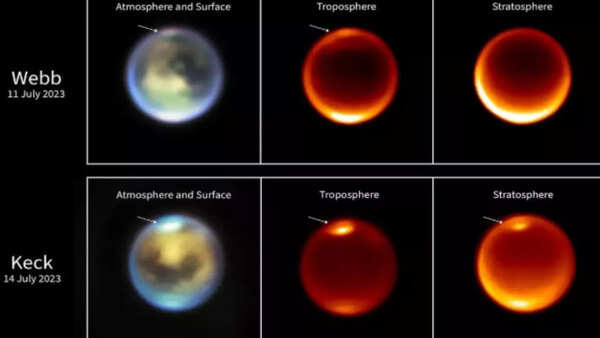Staring up at the starry night sky is normally a source of awe, but scientific investigation can turn such a sense of wonder into discovery. In an unprecedented breakthrough, scientists have watched clouds developing in the northern hemisphere of Titan, Saturn's largest moon, for the first time ever. This landmark sighting, facilitated by the James Webb Space Telescope, gives new insights into Titan's atmospheric phenomena. With its methane lakes and seasonal climate, Titan has been one of the solar system's most mysterious worlds for a long time.
NASA’s James Webb Space Telescope spots first look of Northern Titan clouds
Employing the unprecedented capabilities of the James Webb Space Telescope (JWST), scientists imaged unusual cloud structures in Titan's northern skies during a series of observations in late 2022 and mid-2023. These cloud formations, which are methane clouds, were seen for the first time in the northern hemisphere of the moon — an area that was previously cloudless.
This surprising find was independently confirmed by ground observations from the W. M. Keck Observatory in Hawaii. Combined data verified the occurrence of cloud convection — a process in which warm air becomes buoyant and rises, cooling and producing clouds — the same as weather patterns on Earth. Titan is unique in the solar system as the sole other world with known stable surface liquids. Unlike Earth's water hydrological cycle, Titan has a methane cycle with methane rain, lakes, and even seasonal weather.

Source: NASA
According to the reports, prior to this research, clouds had previously only been recorded on the southern hemisphere of Titan — usually during summer time. The northern hemisphere, which is aptly filled with methane lakes and oceans, was notably quiet and cloud-free. The recent sighting during Titan's northern summer season provides new opportunities to examine its complicated climate patterns.
Dr. Conor Nixon, NASA scientist who directed the study, noted how critical this discovery was. "Titan is special. It's the only place in the universe, outside Earth, where rain and clouds engage with the surface. To observe those changes at the north pole in summer is a game-changer," he said.
JWST and Keck Observatory confirm Titan’s northern clouds
The observations were achieved due to the synergy of sophisticated astronomical equipment. On 11 July 2023, JWST took high-quality photographs of Titan, showing cloud activity at various altitudes. Only a few days later, on 14 July 2023, the Keck Observatory verified these results from Earth. The photographs from both the telescopes showed white arrows indicating methane clouds developing over the northern area.
This cooperative effort not only confirmed the findings but also showed the strength of combining space observations and ground-based observations in planetary science.
JWST completes Cassini’s picture of Titan's weather patterns
The Cassini–Huygens mission, which between 2004 and 2017 studied Saturn and its moons, had earlier taken pictures of cloud activity within Titan's southern hemisphere. Yet it never got a chance to see the north during summer. Thanks to JWST's high-performance infrared imaging and spectroscopy, researchers can now fill in the missing seasonal pieces that Cassini did not leave behind.
Thomas Cornet, a planetary scientist on the project, highlighted the value of these observations. "Webb's look at Titan is valuable. It shows us a glimpse of a very different season and teaches us about how weather patterns evolve over time," he said.
New insights on atmospheric chemistry of Titan
In addition to cloud detection, JWST provided new insights into the atmospheric chemistry of Titan. The telescope identified the presence of a methyl radical — a reactive organic molecule with one carbon atom connected to three hydrogen atoms and having an unpaired electron. This finding is significant since methyl radicals are key players in methane-based atmospheric chemistry. Methane on Titan is degraded by sunlight and by Saturn's magnetospheric charged particles. These fragments recombine into higher-order organic molecules, adding to the thick, foggy atmosphere of the moon.
The discovery of methyl radicals not only informs us about Titan's climate and chemistry but also with larger implications for understanding prebiotic conditions and the possibility of life-supporting environments elsewhere in the universe.
Also Read | ISRO's Aditya-L1 captures solar flare and plasma ejection, monitoring solar activity in near-ultraviolet light | Watch

